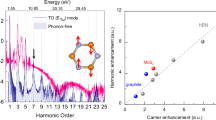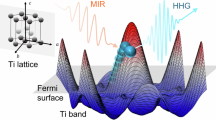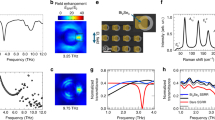Abstract
High-harmonic generation (HHG) in bulk solids permits the exploration of materials in a new regime of strong fields and attosecond timescales1,2,3,4,5,6. The generation process has been discussed in the context of strongly driven electron dynamics in single-particle bands7,8,9,10,11,12,13,14. Two-dimensional materials exhibit distinctive electronic properties compared to the bulk that could significantly modify the HHG process15,16, including different symmetries17,18,19, access to individual valleys20,21 and enhanced many-body interactions22,23,24,25. Here we demonstrate non-perturbative HHG from a monolayer MoS2 crystal, with even and odd harmonics extending to the 13th order. The even orders are predominantly polarized perpendicular to the pump and are compatible with the anomalous transverse intraband current arising from the material’s Berry curvature, while the weak parallel component suggests the importance of interband transitions. The odd harmonics exhibit a significant enhancement in efficiency per layer compared to the bulk, which is attributed to correlation effects. The combination of strong many-body Coulomb interactions and widely tunable electronic properties in two-dimensional materials offers a new platform for attosecond physics.
This is a preview of subscription content, access via your institution
Access options
Subscribe to this journal
Receive 12 print issues and online access
$259.00 per year
only $21.58 per issue
Buy this article
- Purchase on SpringerLink
- Instant access to full article PDF
Prices may be subject to local taxes which are calculated during checkout




Similar content being viewed by others
References
Ghimire, S. et al. Observation of high-order harmonic generation in a bulk crystal. Nat. Phys. 7, 138–141 (2011).
Schubert, O. et al. Sub-cycle control of terahertz high-harmonic generation by dynamical Bloch oscillations. Nat. Photon. 8, 119–123 (2014).
Luu, T. T. et al. Extreme ultraviolet high-harmonic spectroscopy of solids. Nature 521, 498–502 (2015).
Vampa, G. et al. Linking high harmonics from gases and solids. Nature 522, 462–464 (2015).
Hohenleutner, M. et al. Real-time observation of interfering crystal electrons in high-harmonic generation. Nature 523, 572–575 (2015).
Ndabashimiye, G. et al. Solid-state harmonics beyond the atomic limit. Nature 534, 520–523 (2016).
Ghimire, S. et al. Generation and propagation of high-order harmonics in crystals. Phys. Rev. A 85, 043836 (2012).
Golde, D., Meier, T. & Koch, S. W. High harmonics generated in semiconductor nanostructures by the coupled dynamics of optical inter- and intraband excitations. Phys. Rev. B 77, 075330 (2008).
Hawkins, P. G., Ivanov, M. Y. & Yakovlev, V. S. Effect of multiple conduction bands on high-harmonic emission from dielectrics. Phys. Rev. A 91, 013405 (2015).
Higuchi, T., Stockman, M. I. & Hommelhoff, P. Strong-field perspective on high-harmonic radiation from bulk solids. Phys. Rev. Lett. 113, 213901 (2014).
Vampa, G., McDonald, C. R., Orlando, G., Corkum, P. B. & Brabec, T. Semiclassical analysis of high harmonic generation in bulk crystals. Phys. Rev. B 91, 064302 (2015).
Vampa, G. et al. Theoretical analysis of high-harmonic generation in solids. Phys. Rev. Lett. 113, 073901 (2014).
Wu, M., Ghimire, S., Reis, D. A., Schafer, K. J. & Gaarde, M. B. High-harmonic generation from Bloch electrons in solids. Phys. Rev. A 91, 043839 (2015).
Kemper, A. F., Moritz, B., Freericks, J. K. & Devereaux, T. P. Theoretical description of high-order harmonic generation in solids. New J. Phys. 15, 023003 (2013).
Al-Naib, I., Sipe, J. E. & Dignam, M. M. High harmonic generation in undoped graphene: interplay of inter- and intraband dynamics. Phys. Rev. B 90, 245423 (2014).
Kelardeh, H. K., Apalkov, V. & Stockman, M. I. Graphene in ultrafast and superstrong laser fields. Phys. Rev. B 91, 045439 (2015).
Kumar, N. et al. Second harmonic microscopy of monolayer MoS2 . Phys. Rev. B 87, 161403 (2013).
Li, Y. et al. Probing symmetry properties of few-layer MoS2 and h-BN by optical second-harmonic generation. Nano Lett. 13, 3329–3333 (2013).
Malard, L. M., Alencar, T. V., Barboza, A. P. M., Mak, K. F. & de Paula, A. M. Observation of intense second harmonic generation from MoS2 atomic crystals. Phys. Rev. B 87, 201401 (2013).
Xu, X., Yao, W., Xiao, D. & Heinz, T. F. Spin and pseudospins in layered transition metal dichalcogenides. Nat. Phys. 10, 343–350 (2014).
Mak, K. F., McGill, K. L., Park, J. & McEuen, P. L. The valley Hall effect in MoS2 transistors. Science 344, 1489–1492 (2014).
Chernikov, A. et al. Exciton binding energy and nonhydrogenic Rydberg series in monolayer WS2 . Phys. Rev. Lett. 113, 076802 (2014).
He, K. et al. Tightly bound excitons in monolayer WSe2 . Phys. Rev. Lett. 113, 026803 (2014).
Ye, Z. et al. Probing excitonic dark states in single-layer tungsten disulphide. Nature 513, 214–218 (2014).
Mak, K. F. et al. Tightly bound trions in monolayer MoS2 . Nat. Mater. 12, 207–211 (2013).
Xiao, D., Chang, M.-C. & Niu, Q. Berry phase effects on electronic properties. Rev. Mod. Phys. 82, 1959–2007 (2010).
Mak, K. F., Lee, C., Hone, J., Shan, J. & Heinz, T. F. Atomically thin MoS2: a new direct-gap semiconductor. Phys. Rev. Lett. 105, 136805 (2010).
Splendiani, A. et al. Emerging photoluminescence in monolayer MoS2 . Nano Lett. 10, 1271–1275 (2010).
Ellis, J. K., Lucero, M. J. & Scuseria, G. E. The indirect to direct band gap transition in multilayered MoS2 as predicted by screened hybrid density functional theory. Appl. Phys. Lett. 99, 261908 (2011).
Vampa, G. et al. All-optical reconstruction of crystal band structure. Phys. Rev. Lett. 115, 193603 (2015).
Acknowledgements
This project was supported primarily by the Air Force Office of Scientific Research under Grant Nos. FA9550-14-1-0108 and FA9550-14-1-0268. Additional support for Y.L. and T.F.H. was provided by the AMOS program, Chemical Sciences, Geosciences, and Biosciences Division, Basic Energy Sciences, U.S. Department of Energy under Contract No. DE-AC02-76-SFO0515 and by the Gordon and Betty Moore Foundation’s EPiQS Initiative through Grant No. GBMF4545. S.G. and Y.S.Y. acknowledge the support from the Office of Science Early Career Research Program. We thank P. H. Bucksbaum for useful discussions.
Author information
Authors and Affiliations
Contributions
H.L. and Y.L. contributed equally to this work, built the experimental set-up, carried out the measurements and analysed the data. D.A.R. and T.F.H. conceived the experiment. H.L., Y.L., Y.S.Y., S.G., T.F.H. and D.A.R. contribute to the interpretation of the data. All authors contributed to the discussions and the preparation of the manuscript.
Corresponding author
Ethics declarations
Competing interests
The authors declare no competing financial interests.
Supplementary information
Supplementary information
Supplementary information (PDF 1563 kb)
Rights and permissions
About this article
Cite this article
Liu, H., Li, Y., You, Y. et al. High-harmonic generation from an atomically thin semiconductor. Nature Phys 13, 262–265 (2017). https://doi.org/10.1038/nphys3946
Received:
Accepted:
Published:
Issue date:
DOI: https://doi.org/10.1038/nphys3946
This article is cited by
-
Technical review: Time-dependent density functional theory for attosecond physics ranging from gas-phase to solids
npj Computational Materials (2025)
-
Noncollinear harmonic spectroscopy reveals crossover of strong-field effects
Nature Communications (2025)
-
Data-driven low-rank approximation for the electron-hole kernel and acceleration of time-dependent GW calculations
npj Computational Materials (2025)
-
Shaping exciton polarization dynamics in 2D semiconductors by tailored ultrafast pulses
Light: Science & Applications (2025)
-
High harmonic spectroscopy reveals anisotropy of the charge-density-wave phase transition in TiSe2
Communications Materials (2025)



